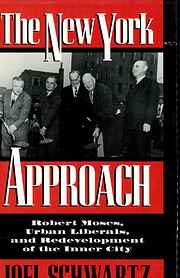|
|
Lädt ... The New York Approach: Robert Moses, Urban Liberals, and Redevelopment of the Inner City| 9 | Keine | 1,988,313 | Keine | Keine | Joel Schwartz's major reinterpretation of urban development in New York City examines Robert Moses's role in shaping the city and demonstrates for the first time that Moses's personal and ruthless crusade to redevelop New York's neighborhoods was actually sustained by his alliance with liberal city groups. After World War II, New York City forged ahead with urban renewal made possible by Title I of the Housing Act of 1949. While Title I was meant to help big cities replace slums with middle-class housing, New York instead used the program to replace housing for the poor with high-rent apartments, medical centers, and university campuses. When Title I became synonymous with callous relocation and "Negro removal," New Yorkers blamed Robert Moses, the legendary construction czar. While many concluded that Moses's high-handed ways were behind much that went wrong with their city, few could explain how he operated in a town famous for its feisty neighborhoods, liberal politics, and pioneer interracialism. From exhaustive research in previously unexamined archives, Schwartz demonstrates the extent to which Moses was abetted by liberal city leaders. He describes how insiders' deals for choice Title I sites emerged from the old ambitions of neighborhood civic groups and public housing advocates, and argues that urban liberals had long been prepared to sacrifice working-class neighborhoods for the city efficient. He explodes the myth of neighborhood resistance to Moses in Greenwich Village, the Upper West Side, and Morningside Heights, and instead finds steady collaboration of local civic leaders. Joel Schwartz's complex, disturbing portrait of Robert Moses and the civic leaders who sustained his power will surprise and enlighten readers interested in the evolution and development of New York and of today's post-industrial cities.… (mehr) |
▾Diskussionen (Über Links) Keine aktuelle Diskussion zu diesem Buch. ▾Reihen und Werk-Beziehungen ▾Auszeichnungen und Ehrungen
|
|
| Gebräuchlichster Titel |
Die Informationen stammen von der englischen "Wissenswertes"-Seite. Ändern, um den Eintrag der eigenen Sprache anzupassen. | |
|
| Originaltitel |
|
| Alternative Titel |
|
| Ursprüngliches Erscheinungsdatum |
|
| Figuren/Charaktere |
Die Informationen stammen von der englischen "Wissenswertes"-Seite. Ändern, um den Eintrag der eigenen Sprache anzupassen. | |
|
| Wichtige Schauplätze |
Die Informationen stammen von der englischen "Wissenswertes"-Seite. Ändern, um den Eintrag der eigenen Sprache anzupassen. | |
|
| Wichtige Ereignisse |
|
| Zugehörige Filme |
|
| Epigraph (Motto/Zitat) |
|
| Widmung |
|
| Erste Worte |
|
| Zitate |
|
| Letzte Worte |
|
| Hinweis zur Identitätsklärung |
|
| Verlagslektoren |
|
| Werbezitate von |
|
| Originalsprache |
Die Informationen stammen von der englischen "Wissenswertes"-Seite. Ändern, um den Eintrag der eigenen Sprache anzupassen. | |
|
| Anerkannter DDC/MDS |
|
| Anerkannter LCC |
|
▾Literaturhinweise Literaturhinweise zu diesem Werk aus externen Quellen.  Wikipedia auf Englisch (1) Wikipedia auf Englisch (1)
▾Buchbeschreibungen Joel Schwartz's major reinterpretation of urban development in New York City examines Robert Moses's role in shaping the city and demonstrates for the first time that Moses's personal and ruthless crusade to redevelop New York's neighborhoods was actually sustained by his alliance with liberal city groups. After World War II, New York City forged ahead with urban renewal made possible by Title I of the Housing Act of 1949. While Title I was meant to help big cities replace slums with middle-class housing, New York instead used the program to replace housing for the poor with high-rent apartments, medical centers, and university campuses. When Title I became synonymous with callous relocation and "Negro removal," New Yorkers blamed Robert Moses, the legendary construction czar. While many concluded that Moses's high-handed ways were behind much that went wrong with their city, few could explain how he operated in a town famous for its feisty neighborhoods, liberal politics, and pioneer interracialism. From exhaustive research in previously unexamined archives, Schwartz demonstrates the extent to which Moses was abetted by liberal city leaders. He describes how insiders' deals for choice Title I sites emerged from the old ambitions of neighborhood civic groups and public housing advocates, and argues that urban liberals had long been prepared to sacrifice working-class neighborhoods for the city efficient. He explodes the myth of neighborhood resistance to Moses in Greenwich Village, the Upper West Side, and Morningside Heights, and instead finds steady collaboration of local civic leaders. Joel Schwartz's complex, disturbing portrait of Robert Moses and the civic leaders who sustained his power will surprise and enlighten readers interested in the evolution and development of New York and of today's post-industrial cities. ▾Bibliotheksbeschreibungen Keine Bibliotheksbeschreibungen gefunden. ▾Beschreibung von LibraryThing-Mitgliedern
| Zusammenfassung in Haiku-Form |
|
|
Aktuelle DiskussionenKeine Google Books Google Books — Lädt ...
BewertungDurchschnitt: Keine Bewertungen.
|


 Google Books — Lädt ...
Google Books — Lädt ...